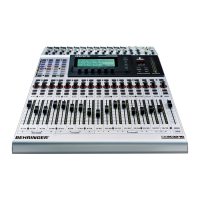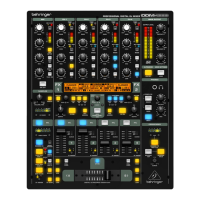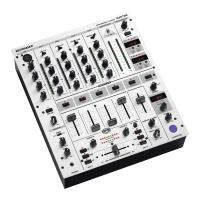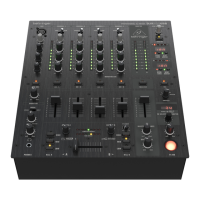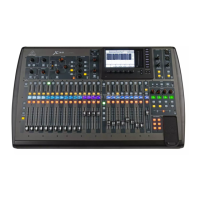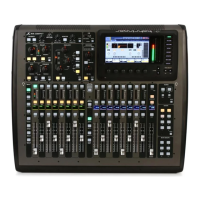37
9. FILE MANAGEMENT
The DDX3216 stores files and settings in an internal flash
memory, i. e. all files and setup settings are preserved when the
mixing console is switched off, except for the UNDO and REDO
files for the dynamic automation, which are stored in a so-called
DRAM, and will get lost after power-down. The current
automation parameters are preserved, as are the setup
parameters, libraries and snapshot memories. What is more,
your DDX3216 stores the last snapshot used and recalls it after
power-up.
All files stored in the DDX3216 can be saved to a PC card or a
Windows
®
PC, using the MIDI or RS232 interfaces. These files
can be used as backups or to transfer data from one DDX3216
to another.
The DDX3216 stores and loads the following file types:
ALL
Single file containing the complete mixer settings (including
setup, user preferences, snapshot, channel library, EQ library,
dynamics library, effects library and dynamic automation settings)
SNAPS
Single snapshot automation file containing all snapshot
memories
CHANLIB
Single channel library file containing all channel libraries
EQ-LIB
Single EQ library file containing all EQ libraries
DYN-LIB
Single dynamics library file containing all dynamics libraries
FX-LIB
Single FX library file containing all effects libraries
AUTOM.
Dynamic automation files
SETUP
DDX3216 setup files
UPDATE!
OS update file (firmware) for the operating software of your
DDX3216 (see chapter 16.1 “Updating the DDX3216 operating
system”)
9.1 Saving/loading files to/from a computer
You can download the free “DDX3216 File Exchange”
software from our website www.ddx3216.com. The software
enables the console to communicate with a Windows
®
PC
(Windows
®
95, or higher).
9.1.1 Communications setup
In order to use the program, you need to establish a connection
between the console and computer, either via the serial PC port
and the RS232 interface on the console, or via a MIDI connection.
RS232 serial interface
Connect the RS232 port on the console (9-pin D connector) to
a free serial port on your PC. Use the enclosed serial cable (1:1
connection). You should also know which COM port is assigned
to the serial port you are using. If in doubt, consult the computer
user manual.
Press the FILES switch in the left switch block of the DDX3216,
until the EXCHANGE page is displayed. Then, select the RS232
port with master controller 1.
Fig. 9.1: EXCHANGE page
On the PC, run the program “DDX3216 File Exchange”. A
connection setup dialog should be displayed (you can also select
the “RS232” option in the CONFIGURATION menu). Select the
menu option “PORT SETUP”, and then the appropriate COM port.
If your computer has only one RS232 interface, you can skip the
selection. Once the connection has been established, the status
line will read the message “Connected via COM ...”.
MIDI
Connect the MIDI OUT port on the console to the MIDI IN port on
the computer, and the MIDI OUT on the PC to the MIDI IN on the
DDX3216.
+ Please note that both connections are required,
even if you are going to transfer data in one direction
only!
Press the FILES switch in the left switch block, until the
EXCHANGE page is displayed. Now select the MIDI port with
master controller 1.
On the PC, run the program “DDX3216 File Exchange”. A
connection setup dialog should be displayed (you can also select
the “MIDI” option in the CONFIGURATION menu). Select the menu
option “PORT SETUP”, and then the appropriate MIDI port. If your
computer has only one MIDI port, you can skip the selection.
Once the connection has been established, the status line will
read the message “Connected via MIDI ...”.
+ The “SEARCH DDX3216” option in the CONFIGURATION
menu of the PC software allows you to poll all RS232
and MIDI ports on your PC, and to adjust the
communications parameters automatically.
9.1.2 File management
Fig. 9.2: Windows
®
software “DDX3216 File Exchange”
The “DDX3216 File Exchange” software comprises three
windows, which display the contents of the PC card inserted
into the PC card slot of the DDX3216 (card files), the contents of
the internal flash memory of the DDX3216 (internal files), and the
contents of the (network) drives of your PC (window on the
right, works similar to a Windows
®
Explorer window).
Use the typical Windows
®
commands (Mark all, rename, delete,
paste, copy, insert) for the management of the various file types
(see chapter 9 “FILE MANAGEMENT”). Naturally, you can
exchange files between the individual windows using the
Windows
®
-typical drag & drop routine.
When stored on a PC, the various file types are given the file
extensions shown in fig. 9.2.
9. FILE MANAGEMENT

